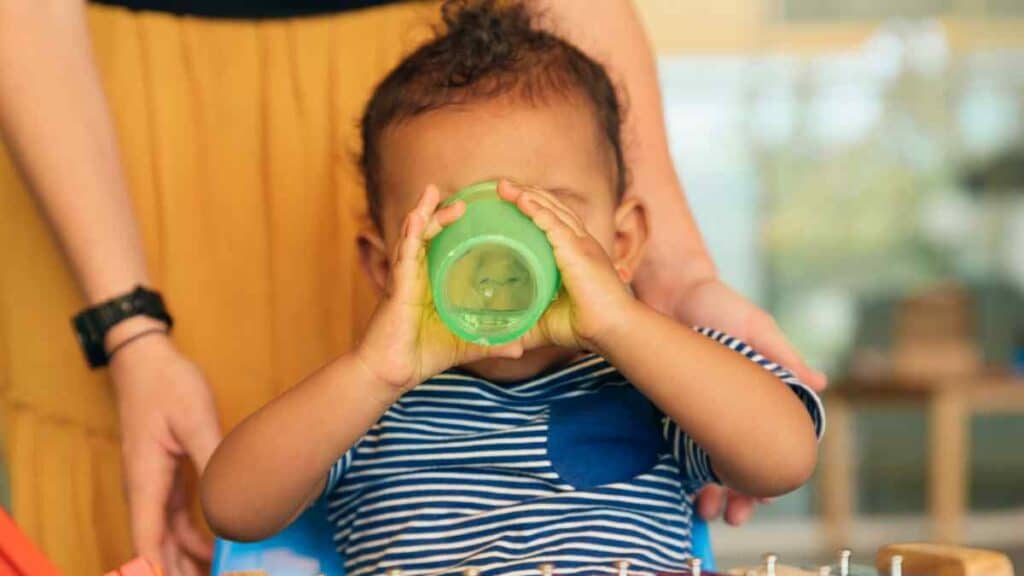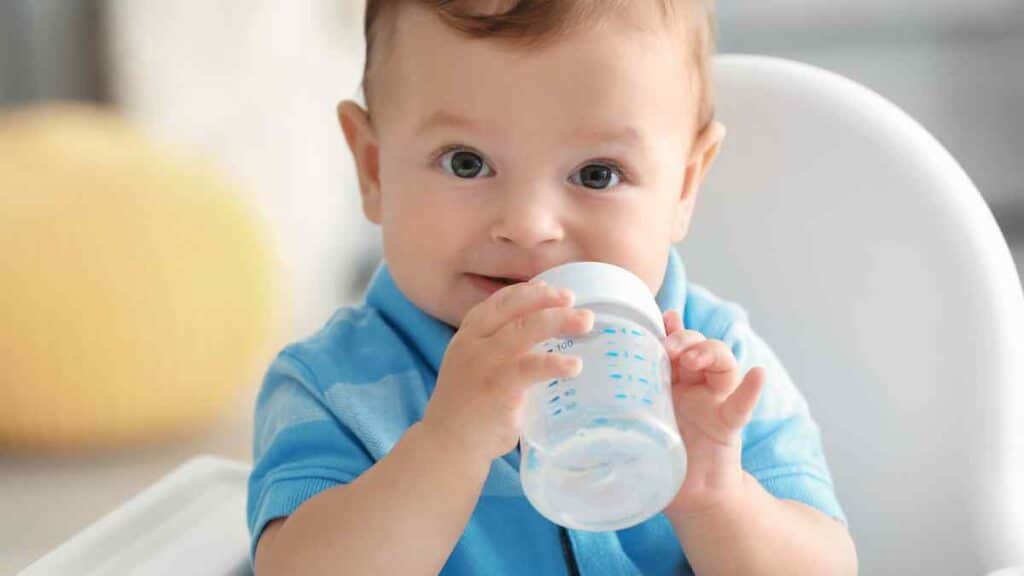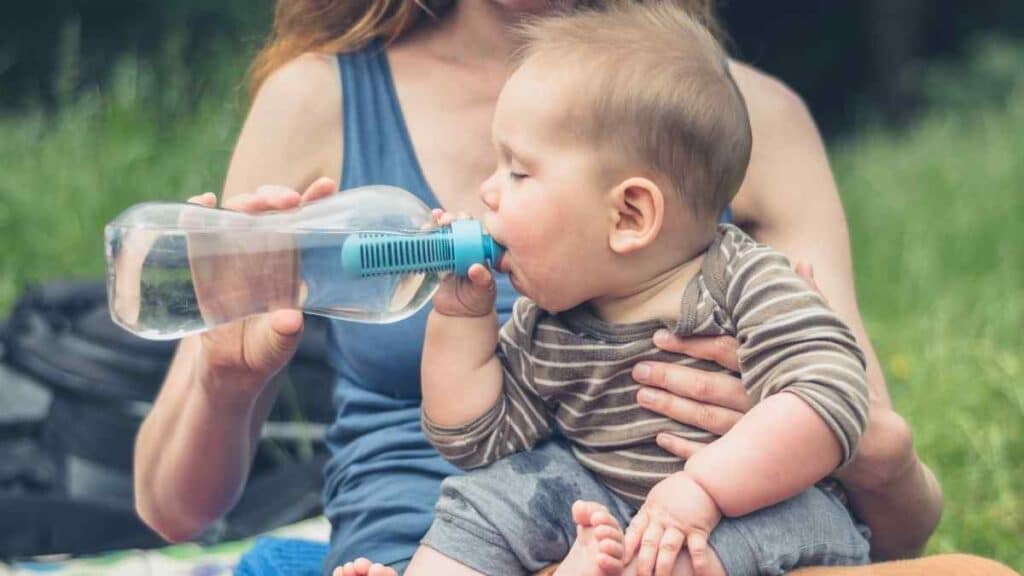As a parent, it’s natural to want to ensure your baby gets everything they need to thrive, including proper hydration. However, knowing when and how to introduce water to your baby can be a bit of a mystery.
While breastmilk or formula should be your baby’s primary source of nutrition, there comes a point when your little one may need some water to stay hydrated. But how do you know when your baby is ready for water, and what’s the best way to offer it to them?
In this blog post, we’ll navigate the waters of introducing baby water, covering everything from when to start offering water to the different types of water to use and mistakes to avoid.

When Can You Start Giving Water to Your Baby?
According to the guidelines set forth by the American Academy of Pediatrics (AAP), it is recommended that parents wait until their infants reach 6 months of age before introducing baby water to their diet.
However, it’s important to note that even after the introduction of baby water, breast milk or mix formula should still be the primary source of hydration for babies. Offering breast milk or formula ensures that babies receive all the hydration they need, as well as all the nutrients necessary for their growth and development.
The Role of Breastmilk/Formula in Hydration for Young Babies
During the first few months of life, babies rely solely on milk for hydration. Breastfed babies will usually nurse on demand, so it’s important for moms to stay well hydrated themselves. Drinking at least 8 cups of water a day can help ensure that they produce enough breast milk for their babies.
For formula fed babies, it’s important to mix the infant formula according to the package instructions to ensure that it provides the right amount of hydration. It’s also important not to dilute formula with extra water, as this can lead to water intoxication, a condition where the baby’s blood becomes too diluted.
If a baby is drinking less breast milk than usual, it may be necessary to offer more frequent feedings or supplement with baby formula.
Signs That Your Baby Is Ready for Water
As a parent, it’s important to make sure your baby is getting enough fluids, but it can be difficult to determine just how much water your little one needs.
Here’s a sign that your baby is ready for water, broken down into physical, developmental, and behavioral categories:
For Physical Signs:
Dry Mouth or Lips
A dry mouth or lips is one of the first signs that your baby is ready for the water. It may seem strange to watch for, but it’s actually a good sign. When babies are born, they have a very high-water content, which helps keep them hydrated and cool. If you notice this to your baby, it means that they have begun to use up that water supply and needs more water intake.
Decreased Interest in Nursing or Bottle-Feeding
Babies who are ready to drink water will show decreased interest in nursing or bottle-feeding. This can be a great indicator of your little one’s readiness to start drinking water because it means they are ready to move on from the comfort of their mother’s milk, which is still the best food for them at this age.
Fewer Wet Diapers Than Usual
If you’ve noticed that your baby is wetting fewer diapers than usual, it might be their time to drink water!
This is a good sign that their body is ready to transition from breast milk or formula to drinking baby water. When babies are ready for this step in their development, they’ll start showing signs of thirstiness, which means they’ll need to drink more liquids than normal.

For Developmental Signs:
Sitting Up Unsupported
The signs that your baby is ready for water are sitting up unsupported and lifting their head when they’re on their stomach or back. This means that they’re developing the strength and coordination to hold their head up and keep it steady while drinking. Your baby might also be able to roll over easily without your help.
Showing an Interest in What You’re Eating or Drinking
When your baby is ready drink water, they’ll show interest in what you’re eating or drinking. They might even reach out and try to grab your glass or fork! If you notice that your baby is grabbing at your glass or reaching for your straw, it’s time to let them try out some water.
Ability to Swallow Thicker Liquids
One of the biggest indicators is the ability to swallow thicker liquids. At about 6 months old, babies’ abilities start to catch up with their needs, and they will be able to swallow thickened liquids, like breast milk or formula. You can offer breast milk with water or formula as early as then.
For Behavioral Signs:
Reaching for Cups or Bottles
If your baby reaches for cups or bottles regularly, it’s a sign that they’re ready for the water. They’ll probably enjoy drinking from it, too (though not as much as milk). If you want your baby to grow up with healthy habits and a love of water, consider introduce water some at this age.
Eagerness to Drink from a Cup or Bottle
As soon as they can hold their heads up, most babies love to practice drinking from a sippy cup or bottle. It’s fun! And it makes them feel like they’re part of the big kids’ club.
Trying to Grab and Drink from Your Cup or Bottle
Babies are ready for water when they show signs of thirst and cup drinking skills. When your baby reaches this stage, it’s time to begin offering them water in addition to breast milk or formula. You’ll want to offer your baby small amounts of water several times a day, but only enough so that they stay hydrated.
How to Give Water to Your Baby?
When introducing water to your baby, it’s important to do so gradually and carefully. It’s also important to offer water in a safe and supervised environment, as babies can easily choke or aspirate on water.

Types of Water to Use
When giving water to babies, it is important to ensure that it is safe and poses no health risks. Here are the types of water that are generally safe for babies:
Tap Water
In most developed countries, tap water is treated and safe to drink. However, it is important to check with your local water authority to ensure that your area’s tap water is safe and does not contain harmful chemicals or contaminants.
Bottled Water
If you prefer to give your baby bottled water, choose a reputable brand that has been tested and certified safe for drinking.
Boiled and Cooled Water
If you are unsure about the safety of the tap water in your area, you can boil the water and then let it cool before giving it to your baby. Boiling water kills any bacteria or viruses that may be present, making it safe for your baby to drink.
Tips for Ensuring Your Baby Gets Enough Water
Babies have very specific water requirements, and it can be challenging to ensure that they get enough water each day. Here are some tips for making sure that your baby stays hydrated:
Breastfeed or formula feed frequently:
- Infants under six months should be exclusively breastfed or formula-fed. Breast milk or formula contains all the water your baby needs, so feed your baby frequently throughout the day.
Offer water with solid foods:
- Once your baby starts eating solid food, you can offer small amounts of water with meals. This will help your baby stay hydrated and make it easier for them to digest their food.
Offer water throughout the day:
- You can offer small sips of water as your baby gets older. Keep a sippy cup or bottle of water on hand and offer it to your baby frequently.
Encourage your baby to drink water:
- As your baby ages, it may start to resist drinking water. To encourage them to drink water, try using a sippy cup or straw cup with a fun design, or offer water with a splash of undiluted fruit juice for flavor. Avoid giving them sweetened drinks.
Monitor your baby’s hydration:
- Keep an eye on your baby’s urine output and ensure it is clear and plentiful. If your baby is not producing enough urine or their urine is dark in color, they may be dehydrated, and you should contact your healthcare provider.

Mistakes to Avoid When Giving Water to Your Baby
When it comes to your baby, you want to be sure you’re doing everything right. That’s why we’re giving you a list of parents’ biggest mistakes when giving their baby water.
Mistake #1: Giving Your Baby Too Much Water
Your baby will get thirsty, but if they drink too much water, they might have an electrolyte imbalance that can be dangerous. So, if you want to give your baby a bottle of H20, try making it half milk and half water instead.
Mistake #2: Not Warming Up the Water First
Baby tummies are sensitive to temperature changes, so don’t just give them cold water straight from the fridge or sink! Heat the water first, then let it cool down for a few minutes before serving it, and even then, only put out a little at a time, so it doesn’t all get warm at once!
Mistake #3: Giving Your Baby Tap Water Instead of Bottled Water
While you may be tempted to use tap water in your baby’s bottle, it is important only to use bottled water. This is because the chlorine and fluoride in tap water can harm your baby’s developing body and can cause tooth decay. Boil tap water first if you are planning to use it, so it is safe for your baby.
Choosing the Ideal Baby Water Bottle
Selecting an appropriate water bottle for your baby is another crucial aspect not to be overlooked when introducing water to your baby’s diet.
Once your baby has shown signs of readiness for starting to sip water, the kind of baby water bottle that will be used could greatly influence the baby’s water-drinking experience. An ideal baby water bottle should be easy for the baby to hold, sip from, and also should be safe against any potential health risks.
Moreover, the bottle or cup must be BPA-free, since Bisphenol A (BPA) is a chemical that could seep into the water and pose health threats especially for babies. Searching for a bottle that is certified as BPA-free could help ensure your baby’s health and safety.
One of the common options is a sippy cup. Sippy cups are perfect for transitioning your baby from sucking to sipping, and most are designed with handles, making them easy for those tiny hands to grasp. However, you’ll want to be on the lookout for those that have a valve. Valves can make the cup spill-proof but at the same time, it requires harder sucking to take a sip.
On the other hand, straw bottles might a suitable alternative. These bottles can help the baby in lip positioning which is a stage in learning foods intake with different textures. It’s important to be aware that straw bottles can cause spills but will make your baby learn to sip quicker.
Remember that whichever type of bottle you choose, ensure that it is clean and safe for your baby. It is recommended to wash and sterilize your baby’s bottle after each use to prevent the spread of germs and bacteria.
The right choice of baby water bottle enhances your baby’s water-drinking experience. Make sure it is BPA-free, safe, and comfortable for your baby to use. They will have a smoother transition to independent drinking, setting the foundation of proper hydration in their toddler years and beyond.

Conclusion
In conclusion, introducing water to your baby can be tricky, but with some knowledge, it can be done safely and effectively. Remember that breastmilk or formula should always be the primary source of nutrition for your little one, and you should wait until your baby is at least six months old before offering them water.
Look for signs that your baby is ready for water, such as, decreased interest in nursing or bottle-feeding, and fewer wet diapers than usual. When you start offering water, do so gradually and in small amounts to avoid overwhelming your baby’s system.
Ultimately, by following the guidelines provided by the American Academy of Pediatrics and using common sense, you can ensure that your baby stays adequately hydrated and healthy throughout their development.



